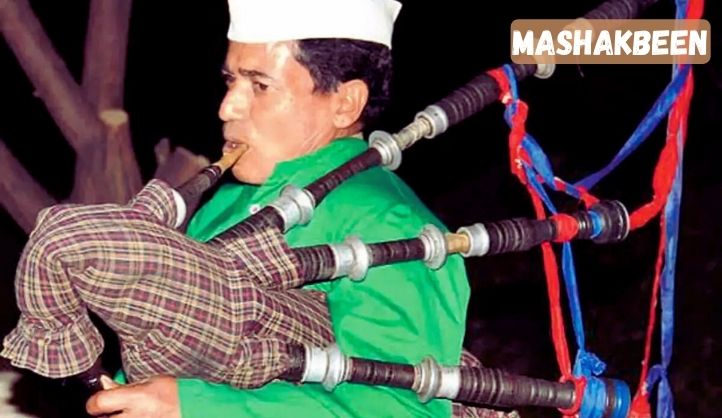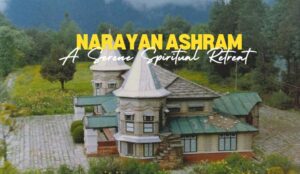Uttarakhand, often referred to as “Devbhumi” or the “Land of the Gods,” is not only renowned for its majestic Himalayan peaks, spiritual retreats, and rich biodiversity but also its vibrant cultural heritage. Among the myriad cultural expressions found in this northern Indian state, traditional music holds a special place, and at the heart of this musical heritage lies the Mashakbeen, a fascinating and distinctive musical instrument.
Origins and History
The Mashakbeen, sometimes simply called Mashak, is a type of bagpipe indigenous to the region. Its history is intertwined with the pastoral life of the people of Uttarakhand, particularly the shepherds and farmers who inhabit the rugged mountainous terrain. The instrument’s name is derived from “Mashak,” meaning a leather bag or bladder, which is the core component of the instrument.
Historically, the Mashakbeen has been a companion of the pastoral communities, who used it to entertain themselves and others during their long, solitary hours in the mountains. The music of the Mashakbeen is deeply embedded in the local folklore and traditions, often accompanying folk dances and rituals.
Construction and Design
The Mashakbeen’s design is both simple and ingenious. It consists of three main parts:
The Bag (Mashak) – Traditionally made from goat or sheep skin, the bag serves as a reservoir of air. The skin is cured and treated to make it airtight and durable. Modern versions may sometimes use synthetic materials, but the traditional leather bag remains the preferred choice for purists.
The Blowpipe (Mukhnaal) – This is a tube through which the player blows air into the bag. It often includes a non-return valve to prevent the air from flowing back out.
The Chanter and Drones (Sur and Jhika) – The chanter is the melody pipe with finger holes, allowing the player to produce different notes. The drones provide a continuous harmonic background. The pipes are usually made of wood or bamboo and are often intricately decorated, reflecting the artisan’s craftsmanship.
Playing Technique
Playing the Mashakbeen requires considerable skill and practice. The musician blows air into the bag through the blowpipe while simultaneously squeezing the bag with their arm to maintain a constant airflow through the chanter and drones. This dual action allows for a continuous stream of music, which is characteristic of bagpipes worldwide.
The melodies produced by the Mashak Been are typically haunting and melodious, perfectly complementing the serene and mystical landscapes of Uttarakhand. The instrument is often played solo, but it can also be part of larger musical ensembles, especially during festivals and cultural gatherings.
Cultural Significance
The Mashakbeen is more than just a musical instrument; it is a symbol of the region’s cultural identity and heritage. Its music is an integral part of various traditional ceremonies, including weddings, festivals, and local fairs. It accompanies traditional dances like the Langvir Nritya and Barada Nati, enhancing the overall festive atmosphere.
Moreover, the instrument is often associated with spiritual practices. In some parts of Uttarakhand, it is believed that the music of the Mashak Been can invoke the presence of deities and spirits, thereby holding a place of reverence in religious rituals.
Some other traditional instruments of Uttarakhand
Damru
The Damru is a small two-headed drum that is widely used in religious rituals and folk music across Uttarakhand. It is typically made from wood or clay, and its rhythmic beats accompany devotional songs and dances during festivals and ceremonies.
Ransingha
The Ransingha is a traditional trumpet-like wind instrument made from a curved buffalo horn. It is played by blowing air through a small hole in the horn’s tip, producing a loud and resonant sound. The Ransingha is often used in processions, religious ceremonies, and cultural events.
Dhol
The Dhol is a double-headed drum played with sticks, and it holds significant cultural importance in Uttarakhand. It is used in various folk dances and celebrations, providing lively rhythms that accompany traditional songs and dances like the Chholiya and the Pandav Nritya.
Hudka
The Hudka is a percussion instrument consisting of a small drum covered with goat or sheep skin. It is played with a stick and is commonly used in folk music to provide a steady beat. The Hurka accompanies various folk dances and cultural performances, adding depth to the musical ensemble.
Sarangi
The Sarangi is a stringed instrument resembling a small, short-necked lute. It has sympathetic strings that resonate with the main strings, creating a rich, melodic sound. The Sarangi is played by bowing the strings and is often used in classical and folk music performances in Uttarakhand.
Dholki
The Dholki is a small barrel-shaped drum with two heads, played with hands or sticks. It is commonly used in folk music and festive celebrations in Uttarakhand, providing a lively beat that energizes dancers and listeners alike.
Bansuri
The Bansuri is a bamboo flute that is played in various musical traditions across India, including Uttarakhand. It produces a soft, melodious tone and is used in both classical and folk music genres. The Bansuri accompanies devotional songs, folk tunes, and classical compositions in the region.
Conclusion
The Mashak Been stands as a testament to Uttarakhand’s rich musical legacy. Its unique sound and deep cultural roots make it an invaluable part of the region’s heritage. As efforts to preserve and promote this traditional instrument gain momentum, there is hope that the haunting melodies of the Mashakbeen will continue to echo through the valleys of Uttarakhand, enchanting listeners for generations to come.
FAQs about the Mashakbeen
1. What is the Mashakbeen?
The Mashakbeen is a traditional musical instrument from Uttarakhand, India. It is a type of bagpipe made from a leather bag (mashak) and wooden or bamboo pipes (chanter and drones).
2. How has the Mashakbeen played?
The musician blows air into the bag through a blowpipe (mukhtar) while simultaneously squeezing the bag to maintain airflow. This action forces air through the chanter (sur) and drones (jhika), producing music.
3. What are the materials used to make the Mashakbeen?
The bag (mashak) is traditionally made from goat or sheep skin, cured to be airtight. The pipes (chanter and drones) are typically crafted from wood or bamboo, often adorned with decorative elements.
4. What kind of music is played on the Mashakbeen?
The Mashakbeen produces haunting, melodious tunes that are integral to Uttarakhand’s folk music. It accompanies local dances, rituals, and festivals, adding a cultural dimension to celebrations.
5. What is the cultural significance of the Mashakbeen?
Beyond its musical role, the Mashakbeen is a symbol of Uttarakhand’s cultural heritage. It is used in traditional ceremonies, religious rituals, and social gatherings, embodying the region’s identity and history.
6. How is the Mashakbeen perceived in modern times?
Efforts are being made to preserve and revive the Mashakbeen, amidst challenges such as the decline of skilled artisans and changing musical preferences. Cultural organizations and enthusiasts are promoting its music through festivals and educational programs.









